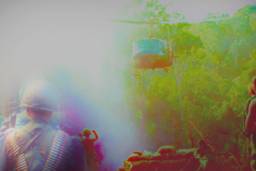
The problem with the picture of Boston bombing suspect Dzhokhar Tsarnaev on the cover of Rolling Stone is simply that it looks like Tsarnaev, a reasonably handsome young man who could be from any decent community in the world. Americans will not stand for truth in representations of alleged criminals.
Largely due to television, movies, and photo selection by the media, we cannot, as Jack Nicholson said, “handle the truth.” A bad guy must look like a bad guy. Someone whom we believe has taken innocent lives must resemble some kind of ogre: rough complexion, crooked or missing teeth, droopy eyes, scruffy hair and clothes. They’re not supposed to look like a clean-cut college boy operating killer drones. Pictures must always fit our perception of the character, good or bad.
We can accept the fact that George W. Bush looks stupid and is stupid, or that Stephen Hawking looks brilliant and is brilliant. We can accept that many political figures look solipsistic and untrustworthy and are just that, while others appear to be honest and decent and are just that, but we cannot have the Green River Killer look like a regular employee at a truck factory. We must find the worst picture we can in order to show how evil he is, even if only one picture out of a thousand can be found. A black man who kills his wife must be made even blacker on the cover of Time to conform to our idea of evil.
We have difficulty dealing with decent images of terrible people. Our minds cannot overcome our eyes. When we mistake a criminal for a decent-looking, average citizen, we admit our weakness. We have been fooled; our primal instinct to detect danger fails to protect us and we are angry.
When a decent picture of John Dillinger appeared after his arrest, good looking and sophisticated, we had to make him into a star for our own sanity. Lawmen posed with him arm-in-arm, all smiling, all content. Not so with Al Capone: a squat, ugly man with a scarred face and fat lips oozing tobacco juice. He fooled no one.
The press picks pictures to fit the crime. Has anyone ever seen a respectable picture of Charlie Manson? Certainly some must exist: publicity pictures from his days as a singer-songwriter, or perhaps shots of him as a young man.
The media often uses booking photos to depict criminals. During the time of their booking, a person is generally confused. They may have been hassled and are likely afraid. If a poor picture cannot be found, no picture is shown. Reporters hunt for personal accounts from people who knew the suspect. “He was always such a nice guy.” “He was quiet and never bothered anyone.” We can discount a personal account but not an image.
Another problem was that Rolling Stone printed the picture. Had almost any other publication printed it, it might have passed without controversy. Rolling Stone is a magazine ostensibly devoted to music and rock stars. A good-looking person’s photo on the cover might confer instant stardom on them. The response would be different if the picture had been printed on the cover of a news magazine. The writer and editor would have used it to provoke the same response in the reader that personal accounts do: “How could a clean-cut, nice-looking man be so demonic?”
A picture of a person is just a picture of a person. It carries no meaning except that which we put into it. The only thing Rolling Stone could have done wrong would have been to print a picture of someone else and say it was Tsarnaev. People claim he looks too much like Jim Morrison. Apparently the one thing we cannot forgive in this country is the crime of resembling someone else. Viewers have forgotten that Morrison was unbalanced and a dope addict — traits somehow acceptable in “artists” but not a person on the streets. People do not always look as they seem or seem as they actually look. Ask any priest.






